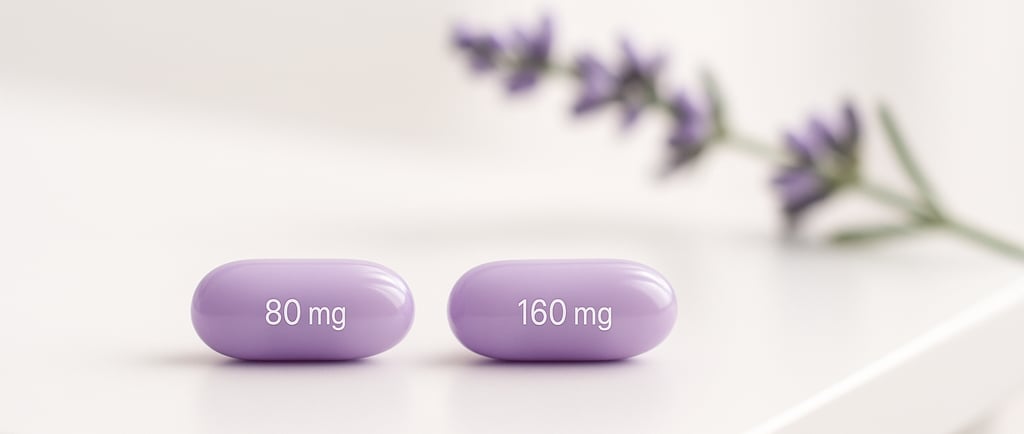Silexan 80 mg vs 160 mg: Which Dose Works Best for Anxiety?
When 80 mg is enough — and when 160 mg shines, according to clinical trials.
8/23/20253 min read


TL;DR: Both doses work. For mild/subthreshold anxiety, 80 mg/day is often enough. For generalized anxiety disorder (GAD) or more pronounced symptoms, 160 mg/day tends to produce larger reductions in anxiety scores and higher responder/remission rates in trials. Start at 80 mg if you’re sensitive or symptoms are mild; step up to 160 mg after ~2–4 weeks if response is partial. SpringerLinkNCBINature
What is Silexan?
Silexan is a standardized oral lavender oil extract (Lavandula angustifolia) in softgel capsules used for anxiety and related sleep disturbance. It has RCT evidence in subthreshold anxiety, MADD, and GAD at 80–160 mg/day. SpringerLink
The Evidence, in Plain English
Head-to-head vs placebo and paroxetine (GAD, 10 weeks):
160 mg/day reduced Hamilton Anxiety (HAM-A) by ~14.1 points,
80 mg/day by ~12.8,
paroxetine 20 mg by ~11.3,
placebo by ~9.5.
Responder (≥50% reduction) rates were 60% (160 mg) vs 52% (80 mg) vs 43% (paroxetine) vs 38% (placebo). Adverse events were similar to placebo and lower than paroxetine. NCBI
Dose-range pooling across two GAD trials:
160 mg/day was consistently superior to placebo on all endpoints; 80 mg/day beat placebo in one trial and in pooled analysis, suggesting 80 mg is the lower end of the therapeutic range. DOINetwork meta-analysis (5 RCTs):
160 mg/day produced a greater decline in HAM-A than 80 mg/day, paroxetine 20 mg, and placebo; 80 mg/day ≈ paroxetine overall. GI side effects (e.g., burping) were the most common; no serious AEs linked to Silexan were reported. NatureMeta-analysis of 5 placebo-controlled trials (80 mg/day):
At 80 mg/day, Silexan was consistently superior to placebo on observer-rated and patient-reported measures across subthreshold anxiety, MADD and GAD, with good tolerability. SpringerLinkComparative trial vs lorazepam (0.5 mg/day):
80 mg/day Silexan improved anxiety similarly to lorazepam without sedation-related complaints common to benzodiazepines. Gwern
So…80 mg or 160 mg?
Choose 80 mg/day if:
Your symptoms are mild/subthreshold or fluctuate with stress.
You’re sensitive to supplements/meds and prefer a gentler start.
You plan to titrate based on response after a couple of weeks.
Evidence: 80 mg/day beats placebo across diagnoses; effect sizes are meaningful, though smaller than 160 mg in GAD. SpringerLink
Choose 160 mg/day if:
You have diagnosed GAD or moderate–severe anxiety burden.
You want the highest probability of a strong response per RCTs/NMA.
You tried 80 mg/day for ~2–4 weeks with partial benefit.
Evidence: Larger HAM-A reductions and higher responder rates at 160 mg vs 80 mg. NCBIDOINature
Onset, Timing & How to Take It
Onset: Early improvements often appear by week 2 and continue to build through week 8–10. The Carlat Report
When to take: Once daily is standard (morning or evening). Take consistently; with food if you’re prone to GI upset (burping/“lavender eructation” is the most common complaint). Nature
Driving & alertness: Trials using 80 mg/day (multiple doses) and single doses up to 320 mg found no impairment of driving performance, unlike benzodiazepines. ScienceDirect
Safety & Interactions (Snapshot)
Common: Mild GI (nausea, burping), occasionally headache. Nature
Sedation/addiction: No sedation signal and no abuse potential in trials and discontinuation studies. Gwern
Cautions: Pregnancy/breastfeeding (insufficient data); discuss with your clinician if you use CNS depressants or have hormone-sensitive conditions. (General supplement caution.)
Not the same as aromatherapy: Evidence here is for oral Silexan capsules, not inhaled oils. Nature
Practical Dosing Flow (not medical advice)
Start 80 mg/day if symptoms are mild or you prefer a conservative approach.
Reassess at 2–4 weeks. If only partial relief, increase to 160 mg/day.
Continue for 8–10 weeks to assess full effect before big changes. The Carlat ReportNCBI
Product Pick (Standardized Silexan)
Recommended: Silexan (Lavender Oil) capsules — standardized, trial-matched extract.
→ Shop Silexan on Amazon (affiliate)
Affiliate disclosure: If you buy through our links, MindRestore may earn a small commission at no extra cost to you.
FAQ
Is Silexan the same as any lavender oil capsule?
No. Silexan is a specific, standardized extract used in clinical trials. Results from aromatherapy or non-standardized capsules don’t necessarily translate. SpringerLinkNature
How long before I notice a difference?
Many people notice changes by week 2, with benefits accruing through weeks 8–10. The Carlat Report
Can I combine Silexan with my SSRI or benzodiazepine?
There are RCT comparisons to paroxetine and lorazepam, but not robust combination studies. If you’re on prescription meds, talk to your clinician before adding Silexan. NCBIGwern
Does 160 mg cause more side effects?
Mostly mild GI effects (burping/nausea) at either dose; overall tolerability is similar to placebo and better than paroxetine in trials. NCBINature
Is it sedating or impairing?
No sedation signal in trials, and no driving impairment demonstrated at studied doses. ScienceDirect
Where can I buy it?
→ Shop Silexan on Amazon (affiliate)
References
Kasper S. et al. GAD RCT: 160 mg and 80 mg Silexan vs paroxetine 20 mg vs placebo; largest HAM-A drop at 160 mg; AEs ≈ placebo. NCBI
Kasper S. et al. Dose-range pooled analysis: 160 mg clearly efficacious; 80 mg = lower end of range. DOI
Network meta-analysis (2019 Sci Rep): 160 mg > 80 mg ≈ paroxetine > placebo; GI AEs mild; no serious AEs linked. Nature
Placebo-controlled meta-analysis (2023): 80 mg/day Silexan superior to placebo across anxiety spectra. SpringerLink
Lorazepam comparator (2010): 80 mg Silexan ≈ lorazepam 0.5 mg without sedation. Gwern
Driving study: No impairment at 80 mg/day or single doses up to 320 mg. ScienceDirect
This article is for educational purposes and not medical advice. Always consult your healthcare professional for personal recommendations.
Trust the science
Natural supplements backed by clinical research.
support@mindrestore.org
© 2025. All rights reserved.